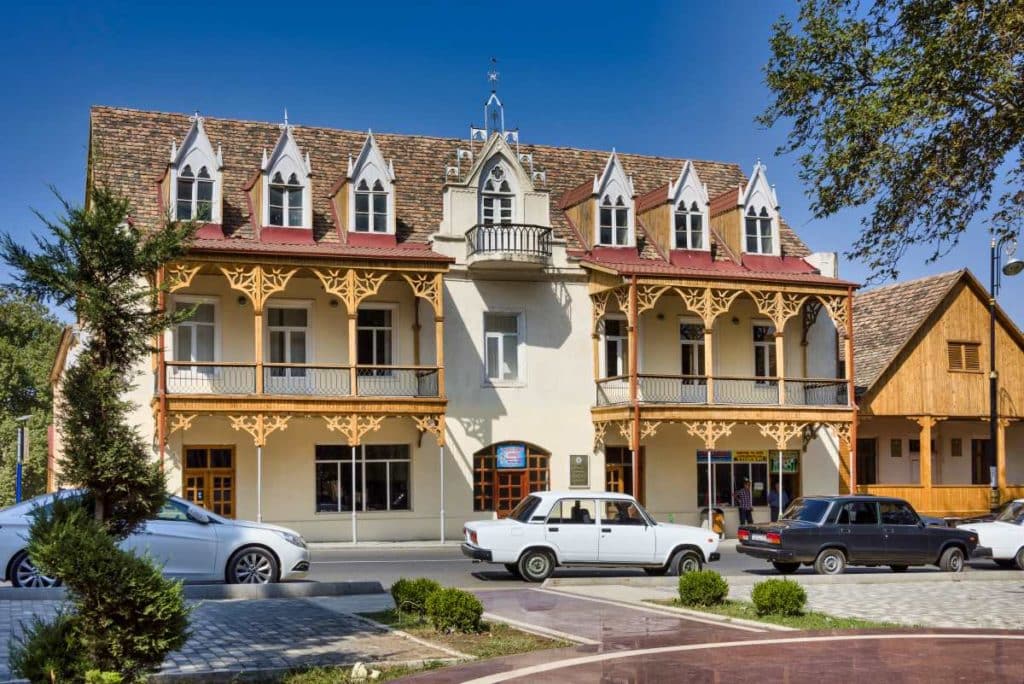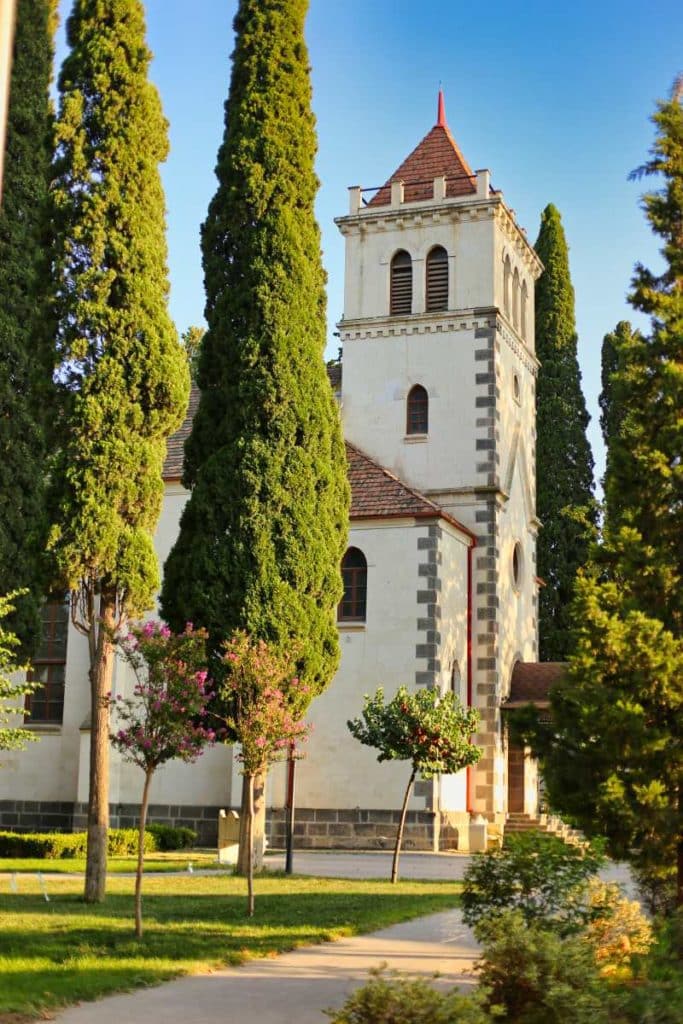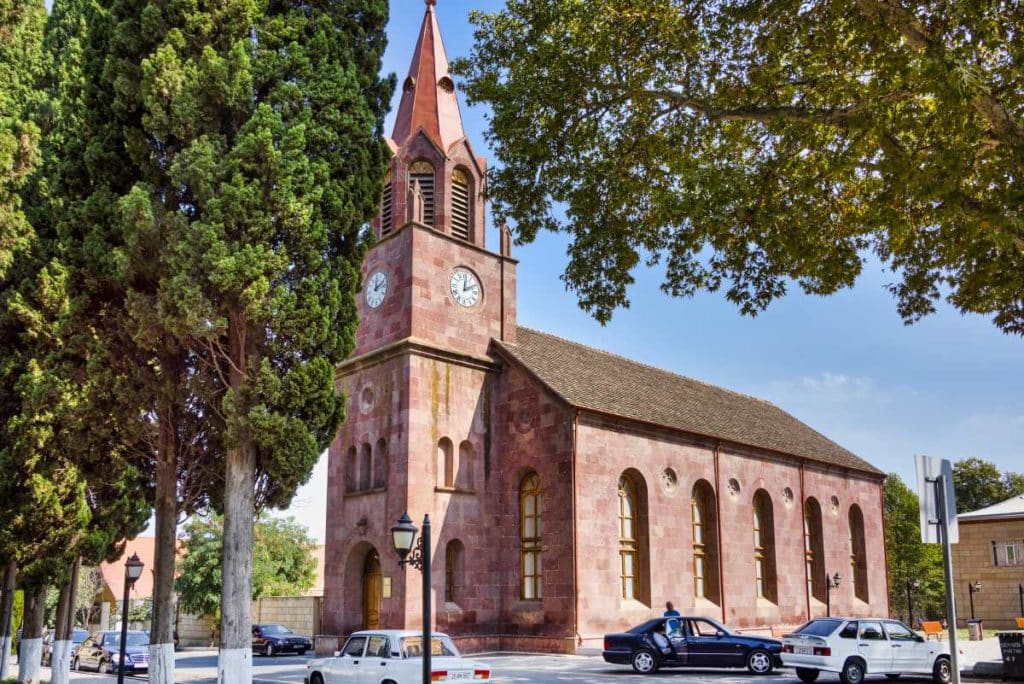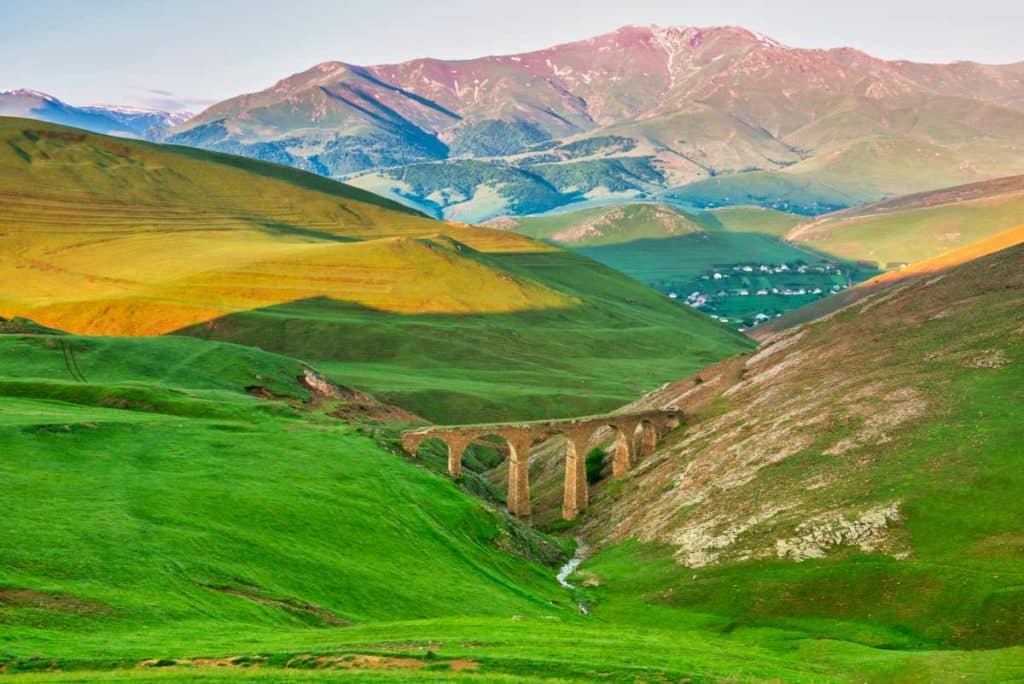The idyllic town of Gəncə in northwestern Azerbaijan is a good starting point for visiting the former German colonies in the Caucasus. The country’s second largest city was not only a cultural and trade center in the Middle Ages, but also the home of Azerbaijan’s national poet Nizami and an important attraction for Germans in Azerbaijan. There is an overnight train from Baku to Gəncə. So the area is easy to reach and we would like to introduce you to the history of Germans in Azerbaijan, a chapter almost unknown in the West.

The Caucasus Swabians
In the first half of the 19th century, Swabian Pietists, who had suffered from looting, tax increases and military conscription in their homeland, accepted the invitation of the Russian tsar, who wanted to populate the newly conquered territories in the South Caucasus. According to the tsar’s understanding of the world, Christian settlers were hardworking, orderly, and loyal. The tsar offered the allocation of land parcels, free practice of religion, exemption from military service, and financial aid. Ships carried the new settlers down the Danube. Some remained in the Black Sea region around Odessa, others, with great difficulty, migrated further to Transcaucasia and settled in Georgia and Azerbaijan. In 1818, the first ten treks, each with 50 families, reached the South Caucasus.
Helenendorf
The center of resettlement in Azerbaijan became the picturesque village of Helenendorf near Gəncə with a view of the mountains (our cover photo shows Mount Kapaz south of Gəncə). The most famous of the German villages in the South Caucasus was called Xanlar from 1938 to 2008, when it was renamed after Göygöl, the mountain or sky lake of the same name in the area.

A life full of hardship
Pointed gable houses with wooden verandas and large gardens with fruit trees suggest a tranquil life in the new home. However, the new settlers had to struggle with epidemics and droughts and had to put up with a lot in order to make economic progress. Initially, silkworm breeding, tobacco and rice cultivation were not successful. In addition to agriculture, the emigrants, specially selected for their professional skills, then concentrated on the cultivation of vines and thus established wine production in Azerbaijan.

Opportunities for Germans in Azerbaijan
In 1850, almost 600 families of German origin lived in the South Caucasus. The Russo-Turkish War at the end of the 19th century, large-scale oil production, and the expansion of the railroad opened up new sales opportunities for fruit and wine, but also for soap, flour, metal tools, wine barrels, and covered wagons. Crafts and trades brought additional income, and the colonist settlements of Helenendorf and Annenfeld (today Şəmkir), only a few kilometers away, as well as smaller villages in the surrounding area prospered. In 1908 Helenendorf had 2400 inhabitants and in 1915 it was the first village in the Caucasus to have electricity, which made the use of engines and machines possible. In 1917 there was already a complete water supply and telephone there!
German wine from the Caucasus
In Helenendorf, the two companies “Hummel” and “Vohrer” founded there produced about 12 million liters of wine annually before the First World War and had established a quasi-monopoly. The Hummel brothers also traded in fruit schnapps and cognac in the Russian Empire. The “Konkordija” winegrowers’ cooperative, founded in part from the assets of the “Hummel” and “Vohrer” companies, was one of the most profitable businesses in the country and had 160 sales outlets. The prosperous company “Gebrüder Vohrer” was taken over by the four sons of the founder Christopher Vohrer in 1892. With elaborate quality control, three-storey wine cellars, state-of-the-art technology and their own railroad connection, they led the company into the future and opened breweries, beer gardens and bowling alleys. Later, they grew cotton on the vast estates, built a stud farm and raised livestock.
Expropriation and banishment
After the October Revolution and the takeover of power by the Bolsheviks, the Germans came under increasing pressure. Already in the second half of the 1920s, a creeping expropriation of the German villages began; the company owners were accused of nationalistic and anti-Soviet activities. The production facilities and vineyards were transferred to so-called sovkhozes. After the company “Konkordija” was completely broken up in 1935, about 600 families were forcibly deported to Karelia. When Hitler’s Germany invaded the Soviet Union in the summer of 1941, tens of thousands of Germans were arrested throughout the country. Stalin had almost 50,000 Caucasian Germans deported, who were taken by truck to Gəncə, by rail to Baku, then by ship across the Caspian Sea to Turkmenistan, and from there on to Omsk in Siberia or to Kazakhstan.

Göygöl today
After the death of Viktor Klein, the “last German in Azerbaijan”, his former home in Helenenstraße was turned into a museum. His grave is in the Xanlar cemetery on the road to Gəncə. Klein himself had never visited Germany. In 2011, a comprehensive restoration of the former colonist villages took place. In the same breath, however, the color palette of the house facades was apparently reduced. Also, the new wooden panels are apparently intended to suggest that the gabled cottages are good German half-timbered.

Locals now live in the picturesque dwellings surrounded by fruit trees and furnished with lush wooden verandas. Often the names of the former owners are still written above the garages and gateways. The villages are still considered a successful example of multicultural Azerbaijan. Some wine cellars can still be visited, and there is a small sale in the local wine factory. The Lutheran Church of St. John, built in 1845 and recently renovated, is also worth a visit; it now functions as a museum. A marshrutka (minibus) leaves Gəncə every 20 minutes for Göygöl or for Şəmkir. Şəmkir today has 40,000 inhabitants and – of course – also a church, but it was built only in 1909. In the local history museum there, photos recall the life of the Swabians in the Caucasus, first full of privation and later pleasant.
The Siemens brothers in Azerbaijan
In addition to electrical engineering, which had led the Siemens brothers to the Tsarist Empire, they were interested in copper production and later in oil production and processing in the Caucasus. South of Şəmkir is the village of Gədəbəy, where the brothers left their mark. Carl von Siemens acquired a copper deposit in 1864 and built a mine that later even produced silver and gold. Copper processing at times covered a quarter of Russia’s total copper requirements.
Cobalt, ore, oil and gold
In Dashkasan, about 40 kilometers away, they started a cobalt mine a year later and built a plant to mine the iron ore. Gədəbəy became home to 300 German families, even though the place was difficult to access in a mountain massif. When the railroad connection was opened in 1883 between Tbilisi and today’s Gəncə and later to Baku, new opportunities opened up. In 1885, the brothers succeeded in converting their huge smelting furnace to oil firing.
In 1881, the Siemens brothers controlled 270 oil wells in the Caucasus. But to transport the new fuel (naphtha) on a large scale, a pipeline was needed. The Mannesmann company offered to supply rolled pipes. Transporting the pipes by rail, ship and cart to the rough terrain turned out to be a difficult undertaking. Nevertheless, the first Naphta route (oil pipeline) in Caucasia went into operation in 1894. From then on, Mannesmann produced in Russia and also supplied the Caucasus with its pipes from there.
The Museum of Regional History
In the museum of regional history in Gəncə you can find original documents of the Siemens company. In Gədəbəy you can visit the Siemens exhibition in the local House of Culture.

An impressive bridge
From Şəmkir buses go to Gədəbəy. After four kilometers you reach the historical railroad bridge, which also served as a backdrop for the filming of the Azerbaijani love story of “Ali and Nino”.
Book recommendations
This book helps you to understand Azerbaijan’s troubled history. Well written, short, but concise!
- Johenning, Heike Maria (Author)
Ali and Nino is the classic of Azerbaijnai literature and tells a love story.
- Said, Kurban (Author)
To prepare your trip, it is best to learn a few words in Azerbaijani. This book is great for beginners!
Portrait of Azerbaijan, presenting the country in all its facets.
Classical travel guide, that also covers Armenia and Georgia.
- Holger Kretzschmar (Author)


Schmerzhafte Echos aus der Vergangenheit
Thank you for the best Azerbaijan travel guide on the internet! German influence in architecture is clearly felt.